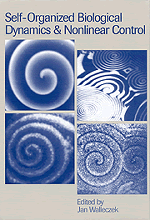 Self-Organized Biological Dynamics and Nonlinear Control
Self-Organized Biological Dynamics and Nonlinear Control Book contents
- Frontmatter
- Contents
- List of contributors
- Preface
- The frontiers and challenges of biodynamics research
- Part I Nonlinear dynamics in biology and response to stimuli
- Part II Nonlinear sensitivity of biological systems to electromagnetic stimuli
- Part III Stochastic noise-induced dynamics and transport in biological systems
- Part IV Nonlinear control of biological and other excitable systems
- Index
Part III - Stochastic noise-induced dynamics and transport in biological systems
Published online by Cambridge University Press: 14 August 2009
- Frontmatter
- Contents
- List of contributors
- Preface
- The frontiers and challenges of biodynamics research
- Part I Nonlinear dynamics in biology and response to stimuli
- Part II Nonlinear sensitivity of biological systems to electromagnetic stimuli
- Part III Stochastic noise-induced dynamics and transport in biological systems
- Part IV Nonlinear control of biological and other excitable systems
- Index
Summary
The consideration of random fluctuations is central to any discussion of the limits of biological stimulus–response interactions. The conventional view holds that stochastic perturbations diminish the efficiency of biological signal detection and transduction pathways. Part III provides an overview of the recently found constructive role of noisy fluctuations in biochemical and biological processes. Two major concepts have emerged for describing such noise-facilitated processes, stochastic resonance and fluctuation-driven transport. In Chapter 10, Frank Moss opens with an overview of the history and of the physical principles of stochastic resonance. He then extends this discussion into the realm of biology and medicine, and offers experiments that demonstrate stochastic resonance in the detection by organisms of dynamical signals, including weak electric fields. The chapter concludes with new evidence for spatiotemporal stochastic resonance in two-dimensional systems. Sergey Bezrukov and Igor Vodyanoy take the discussion of stochastic resonance to the molecular level in Chapter 11. Their experiments demonstrate the noise-improved transduction of electrical signals by voltage-gated ion channels in a planar lipid bilayer.
- Type
- Chapter
- Information
- Self-Organized Biological Dynamics and Nonlinear ControlToward Understanding Complexity, Chaos and Emergent Function in Living Systems, pp. 235Publisher: Cambridge University PressPrint publication year: 2000
